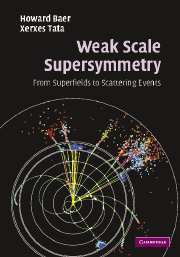Book contents
- Frontmatter
- Contents
- Preface
- 1 The Standard Model
- 2 What lies beyond the Standard Model?
- 3 The Wess–Zumino model
- 4 The supersymmetry algebra
- 5 Superfield formalism
- 6 Supersymmetric gauge theories
- 7 Supersymmetry breaking
- 8 The Minimal Supersymmetric Standard Model
- 9 Implications of the MSSM
- 10 Local supersymmetry
- 11 Realistic supersymmetric models
- 12 Sparticle production at colliders
- 13 Sparticle decays
- 14 Supersymmetric event generation
- 15 The search for supersymmetry at colliders
- 16 R-parity violation
- 17 Epilogue
- Appendix A Sparticle production cross sections
- Appendix B Sparticle decay widths
- Appendix C Higgs boson decay widths
- Bibliography
- Index
10 - Local supersymmetry
- Frontmatter
- Contents
- Preface
- 1 The Standard Model
- 2 What lies beyond the Standard Model?
- 3 The Wess–Zumino model
- 4 The supersymmetry algebra
- 5 Superfield formalism
- 6 Supersymmetric gauge theories
- 7 Supersymmetry breaking
- 8 The Minimal Supersymmetric Standard Model
- 9 Implications of the MSSM
- 10 Local supersymmetry
- 11 Realistic supersymmetric models
- 12 Sparticle production at colliders
- 13 Sparticle decays
- 14 Supersymmetric event generation
- 15 The search for supersymmetry at colliders
- 16 R-parity violation
- 17 Epilogue
- Appendix A Sparticle production cross sections
- Appendix B Sparticle decay widths
- Appendix C Higgs boson decay widths
- Bibliography
- Index
Summary
We know that the superpartners of SM particles must acquire SUSY breaking masses, since otherwise they would have been produced in experiments via their gauge interactions. This requires an understanding of the mechanism of supersymmetry breaking. A variety of models for supersymmetry breaking have been postulated in the literature. The general consensus seems to be that the SM superpartners cannot acquire tree-level masses via spontaneous breaking of global supersymmetry at the TeV scale: we have seen in Chapter 7 that this leads to phenomenological problems with tree-level sum rules which imply that some sfermions must be lighter than fermions. Within the framework of the MSSM our ignorance of the SUSY breaking mechanism is parametrized by 178 soft SUSY breaking parameters.
The MSSM is, therefore, regarded as a low energy effective theory to be derived from a theory that incorporates supersymmetry breaking. In the next chapter, we will discuss various models for the generation of soft SUSY breaking parameters that have been suggested in the literature. These models circumvent the problems with the sum rules in one of two different ways. Either the models are based on local supersymmetry, or the soft SUSY breaking parameters are generated only at the loop level. As preparation for a discussion of the first of these classes of models, in this chapter we present a short discussion of locally supersymmetric theories where the parameters of SUSY transformations depend on the spacetime co-ordinates. Since supersymmetry is a spacetime symmetry, local supersymmetry necessarily involves gravitation. Local supersymmetry is, therefore, also referred to as supergravity. Supergravity is a large and complex subject in its own right, and its elaboration is beyond the scope of this book.
- Type
- Chapter
- Information
- Weak Scale SupersymmetryFrom Superfields to Scattering Events, pp. 235 - 260Publisher: Cambridge University PressPrint publication year: 2006



